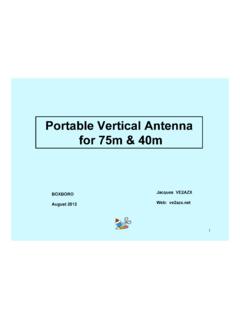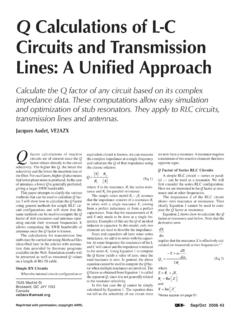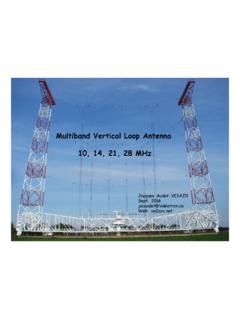Transcription of RETURN LOSS BRIDGE SCHEMATIC Models 1, 2, 3
1 RETURN loss BRIDGE SCHEMATICM odels 1, 2, 3 Revised March 2015J. Audet VE2 AZXWeb: 1206 INPUTPORTTESTPORTOUTPUTPORTRG#174 coaxwith Ferrite beads2X100 12062X100 1206RG#174 coaxThis BRIDGE design does not use a transformer with magnetic it uses a current balun to pickup the BRIDGE voltage. That makes it inherently very wideband. The balun impedance must be kept high over the frequency range of the BRIDGE , since this impedance effectively appears in parallel with the unknown. A compensating impedance is used across the internal BRIDGE reference termination to maintain balance at the frequency extremes of the BRIDGE . This design is used in many commercial the beads placed close to the PCB, you need to measure the BRIDGE directivity while you move the beads away from the on one side, then you try the other side.
2 One bead at a time, then two or three, until you find a spot that gives the highest directivity between 300 and 2000 's best to use a network analyzer setup so that you can observe the frequencyresponse in real attach the bead, use anything that is non metallic, such as tie wraps, cords, RG174 cable lengths should be about the same, the exact length is not use the length that is required as I resistor tolerance: % giving 64 dB atten. worst case.#50 dB BRIDGE attenuation worst case, #60 dB average with 1 % resistors#70 dB BRIDGE attenuation worst case, #80 dB average with % resistors50 ohmbridgeresistors50 ohmterminationINPUTOUTPUT50 ohmSemi#rigid coaxCu wireSame diam as coaxTEST PORTRETURN loss BRIDGE model 1 100 KHz 1000 MHzVE2 AZXRETURN loss BRIDGE model 2 20 KHz 2000 MHzVHF#UHF beads on RG#174 beads on each side, FT23#77RG#174 wound onLF#HF large toroidFT150A#W.
3 6 turnsTEST PORTPCB as in model 3 Felt pad gently holding thetoroid in place with a pads per disk(removed) in. thickPlexiglass in. thickat the bottom to spacethe two toroids from groundNote that the beads have beenattached with cords to secure them in place and optimize #W ferrtie core dimensions:OD : : : : 10 000 Same enclosureas BRIDGE model 3VE2 AZXRETURN loss BRIDGE model 2 20 KHz 2000 MHzNotice the coax connectionto the BNC the center conductor short. VE2 AZXDIRECTIVITY & TEST PORT RETURN loss #50#45#40#35#30#25#20#15#10# 10000 FREQUENCY MHzdBDirectivityTest Port Ret LossInsertion LossRETURN loss BRIDGE model 2 performance testsVE2 AZXRETURN loss BRIDGE model 3 1 MHz to 2500 MHzRG#174 coaxLF#HF toroidsVHF#UHFbeadsCrimped BNCB ridge inputVE2 AZXB ridge outputRG#174 coax(Internal cond.)
4 Not used).Same length as bridgeoutput coax. Connect to gndTest PortPCBN connector flat backRG#174 coaxUse two Fair#Rite #2631250202 Amidon equivalent: FB#31#0202u = 1500 (31 material) in / in. and in. longUse five Amidon FB43#801 beadsor Fair#Rite 43 beads : 2643000801 RETURN loss BRIDGE model 3 N Connector with PCBS elected 100 ohm 1%1206 size BRIDGE resistorsin parallel ( ) BRIDGE inputRG#174 coaxCopper foil to interconnectPCB ground to N connector(Foil completely covers PCBunderneath)Added 2 tappedholes and screwto secure PCBon N connectorN connectormounting holesRG#174 coax shieldBridge outputVE2 AZXPCB gnd planeRETURN loss BRIDGE model 3 BRIDGE mounted in its enclosureAir bubble materialto hold coax cablesSilicone to hold theferrites in place after adjustmentby changing the ferrite positionTie#wrapVE2 AZXTest for RETURN loss BRIDGE Models 2 and 3VE2 AZXHole to secure PCBon N connectorHole to secure PCBon N connectorSee slide 5 RETURN loss BRIDGE model 3 Short / Open ResponseShortOpen0 dB1 MHz100 MHzVE2 AZXRETURN loss BRIDGE model 3 Short -Open Response0 dB1 MHz100 MHzVE2 AZXRETURN loss BRIDGE model 3 Directivity w/r to open0 dB1 MHz100 MHzVE2 AZXRETURN loss BRIDGE model 3 Directivity w/r to short0 dB1 MHz100 MHzVE2
5 AZXRETURN loss BRIDGE model 3 RETURN loss at Input 50 ohm at test port0 dB1 MHz100 MHzVE2 AZXRETURN loss BRIDGE model 3 StocklistQTY10 Amidon FB43#801 Ferrite beads (u=850)or Fair#Rite 43 SHIELD BEAD: 2643000801 u = 800 (43 material) in / in. and in. LongUse 5 per Use Fair#Rite 31 SHIELD BEAD: 2631250202 Amidon equivalent: FB#31#0202u = 1500 (31 material) in / in. and in. longUse two per side. 2 BNC Bulkhead Jacks, RG174 Digikey # A1813#ND1 N type connector with flat back1 Al Case Hammond Manufacturing # 1590B6 Selected 100 ohm +/# ohm 1206 SMT resistors1 PCB18 in. RG174 miniature that high freq performance critically depends on:1# Using a small PCB, located behind the N test # Using RG174 bulkhead BNC # Adjusting the location of the ferrite beads for best balance, preferably by looking at theS21 curve from 500 to 3000 43 SHIELD BEAD: 2643000801u = 800 (43 material) in / in.
6 And in. longVery close to Amidon FB43#801 Use five per sideZ x5Z Total 40 94210 390315 591460 920545 10251 MHzVE2 # #Rite authorized distributors: # 31 SHIELD BEAD: 2631250202u = 1500 (31 material) in / in. and in. longUse two per sideZ x254140180276460480VE2 # FT-23H Measured data vs Fair-Rite spec for type 31 #2631250202




